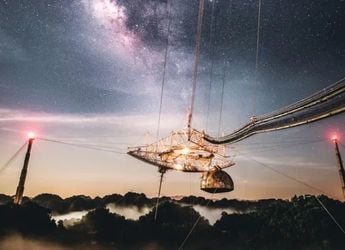- Home
- Science
- Science News
- NASA's Hubble Telescope Spots Runaway Supermassive Black Hole Leaving Behind Trail of Newborn Stars
NASA's Hubble Telescope Spots Runaway Supermassive Black Hole Leaving Behind Trail of Newborn Stars
The black hole lies at one end of the column, at the other end of which lies its parent galaxy.

Photo Credit: NASA
The black hole was seen racing so fast that it could travel from Earth to the Moon in 14 minutes
A supermassive black hole, weighing as much as 20 million Suns, has left behind a 2,00,000-light-year-long condensed trail of newborn stars, twice the diameter of the Milky Way galaxy, in its wake, according to the National Aeronautics and Space Administration (NASA), US.
Captured accidentally by NASA's Hubble Space Telescope, the black hole was seen racing through the intergalactic space so fast that, within our solar system, it could travel from Earth to the Moon in 14 minutes.
"We think we're seeing a wake behind the black hole where the gas cools and is able to form stars. So, we're looking at star formation trailing the black hole," said Pieter van Dokkum of Yale University in New Haven, Connecticut, US.
"What we're seeing is the aftermath. Like the wake behind a ship, we're seeing the wake behind the black hole," said van Dokkum.
The researchers have published their paper in The Astrophysical Journal Letters.
They said that the black hole lies at one end of the column, at the other end of which lies its parent galaxy. They think that the gas is being 'shocked' and heated from the motion of the black hole hitting the gas, or it could be radiation from an accretion disk around the black hole.
"This is pure serendipity that we stumbled across it," van Dokkum added. He was looking for globular star clusters in a nearby dwarf galaxy.
"I was just scanning through the Hubble image and then I noticed that we have a little streak. I immediately thought, 'oh, a cosmic ray hitting the camera detector and causing a linear imaging artifact.' When we eliminated cosmic rays we realized it was still there. It didn't look like anything we've seen before," said van Dokkum.
Van Dokkum and his team followed up the sight with spectroscopy with the W M Keck Observatories in Hawaii. The star trail being "quite astonishing, very, very bright and very unusual" made them conclude that they were looking at the aftermath of a black hole flying through a halo of gas surrounding the host galaxy.
Astronomers suspect this phenomenon to likely be the result of multiple collisions of supermassive black holes, the first two having perhaps merged 50 million years ago. Brought together closer at their centres, they whirled around each other as a binary black hole, they said.
Then came another galaxy with its own supermassive black hole, mixing up the three to form a chaotic and an unstable configuration. One of the black holes robbed momentum from the other two black holes and got thrown out of the host galaxy, they said.
Following this, the remaining binary system of black holes shot off in the opposite direction, they said.
There is a feature seen on the opposite side of the host galaxy that might be the runaway binary black hole. Circumstantial evidence for this is that there is no sign of an active black hole remaining at the galaxy's core, they said.
The next step, they said, would be to do follow-up observations with NASA's James Webb Space Telescope and the Chandra X-ray Observatory to confirm the black hole explanation.
Catch the latest from the Consumer Electronics Show on Gadgets 360, at our CES 2026 hub.
Related Stories
- Samsung Galaxy Unpacked 2025
- ChatGPT
- Redmi Note 14 Pro+
- iPhone 16
- Apple Vision Pro
- Oneplus 12
- OnePlus Nord CE 3 Lite 5G
- iPhone 13
- Xiaomi 14 Pro
- Oppo Find N3
- Tecno Spark Go (2023)
- Realme V30
- Best Phones Under 25000
- Samsung Galaxy S24 Series
- Cryptocurrency
- iQoo 12
- Samsung Galaxy S24 Ultra
- Giottus
- Samsung Galaxy Z Flip 5
- Apple 'Scary Fast'
- Housefull 5
- GoPro Hero 12 Black Review
- Invincible Season 2
- JioGlass
- HD Ready TV
- Laptop Under 50000
- Smartwatch Under 10000
- Latest Mobile Phones
- Compare Phones
- Samsung Galaxy A07 5G
- Vivo Y500i
- OnePlus Turbo 6V
- OnePlus Turbo 6
- Itel Zeno 20 Max
- OPPO Reno 15 Pro Mini 5G
- Poco M8 Pro 5G
- Motorola Signature
- Lenovo Yoga Slim 7x (2025)
- Lenovo Yoga Slim 7a
- Realme Pad 3
- OPPO Pad Air 5
- Garmin Quatix 8 Pro
- NoiseFit Pro 6R
- Haier H5E Series
- Acerpure Nitro Z Series 100-inch QLED TV
- Asus ROG Ally
- Nintendo Switch Lite
- Haier 1.6 Ton 5 Star Inverter Split AC (HSU19G-MZAID5BN-INV)
- Haier 1.6 Ton 5 Star Inverter Split AC (HSU19G-MZAIM5BN-INV)

















